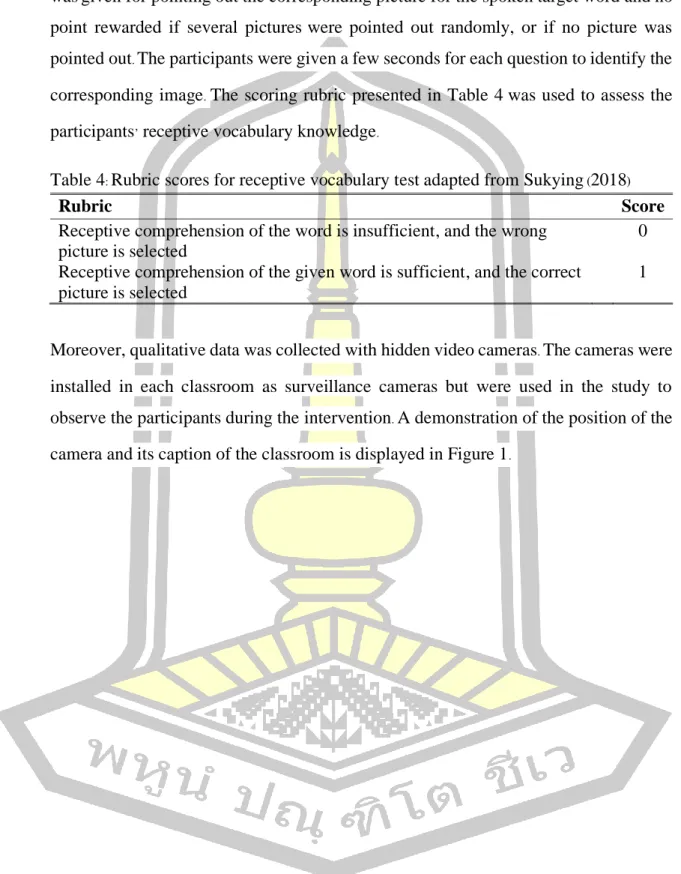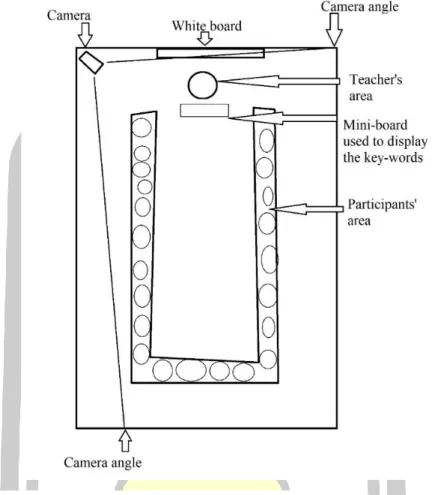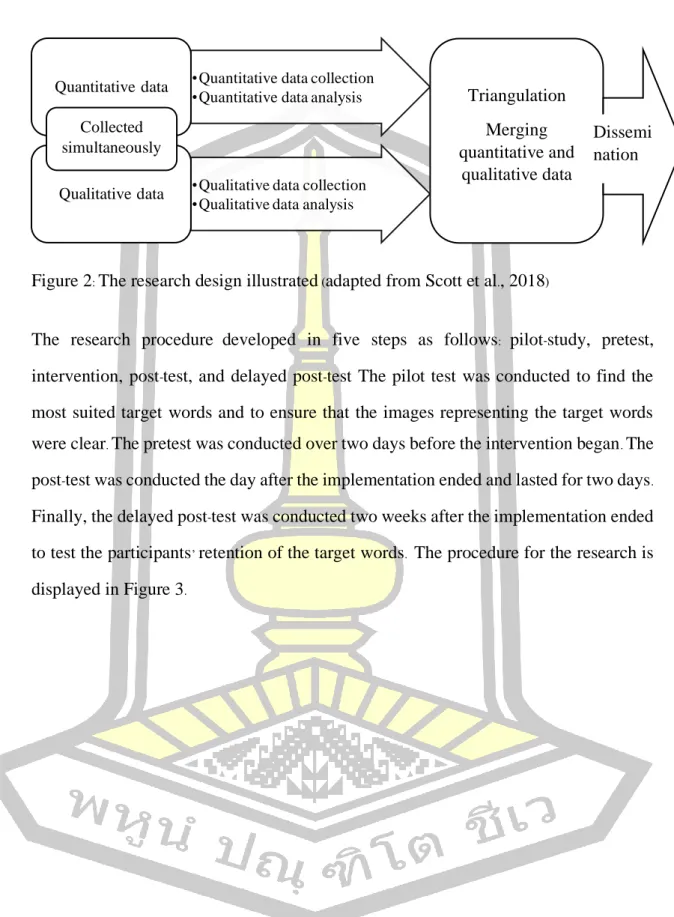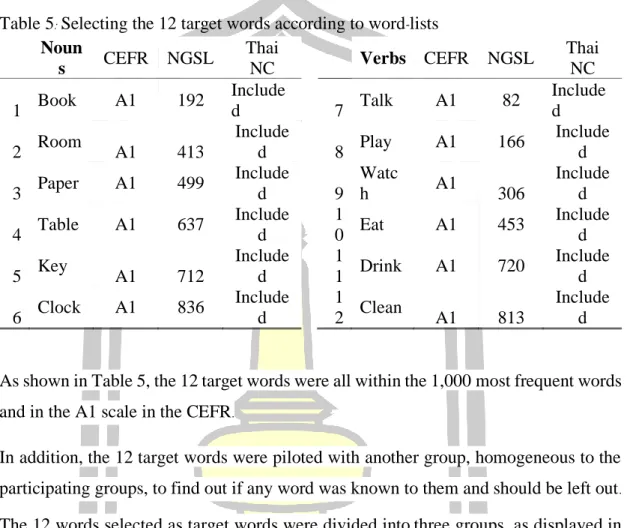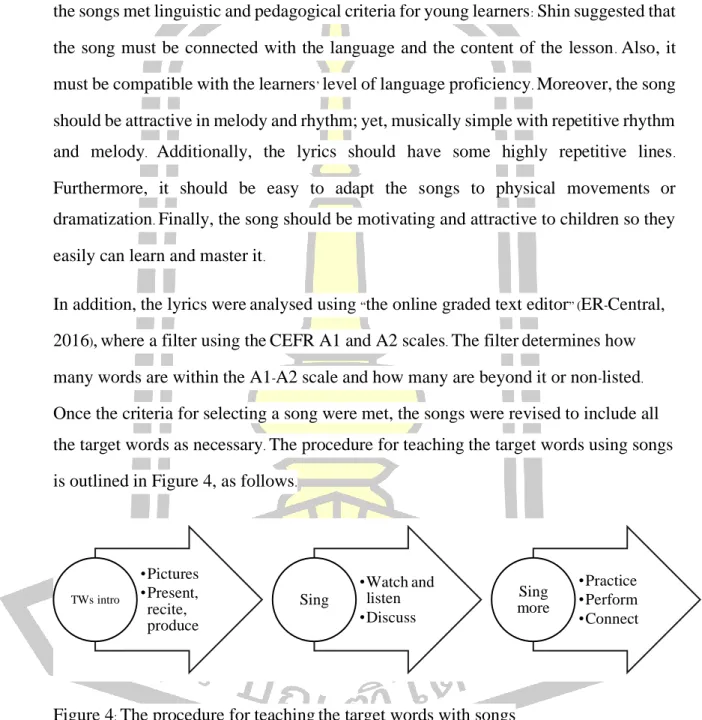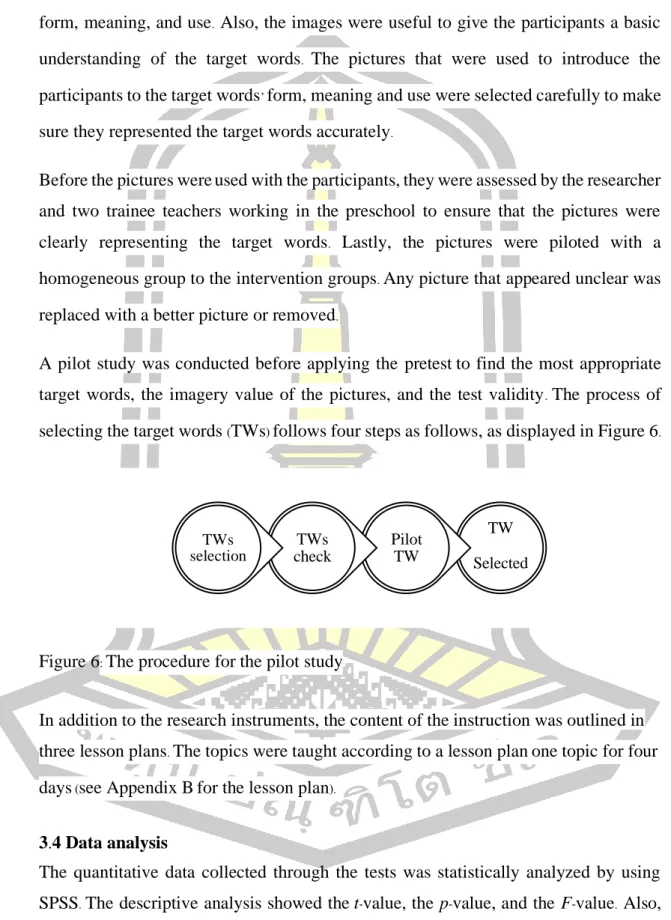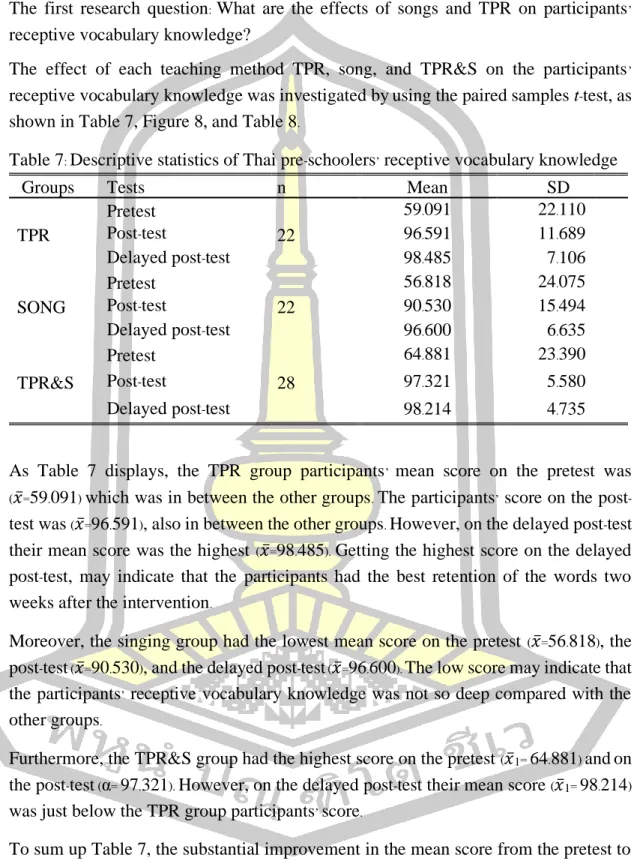The examination board unanimously approved this thesis submitted by Mr. Ernst Suni Magnussen, in partial fulfillment of the requirements for the MA in English Language Teaching at Mahasarakham University. Mahasarakham University has approved acceptance of this assignment in partial fulfillment of the requirements for the MA in English Language Teaching. Therefore, the current investigation examined the effects of song performance and TPR on preschool children's vocabulary acquisition in a Thai EFL context.
Indeed, songs and TPR were effective in learning the target words and facilitated dynamic interactions in the classroom. However, the short period of the intervention and the small number of participants limited the results. Finally, singing and TPR can be recommended for teaching young learners English vocabulary in EFL contexts.
In addition, I would like to appreciate all the faculty members of the ELT program and my classmates. In addition, my sincere gratitude goes to the precious children whom I had the privilege of teaching and observing during the period of the research experiment.
INTRODUCTION
Background
Positive contributions such as higher motivation, enjoyment, improved listening skills and better pronunciation are important for vocabulary acquisition (Sullivan, 2016, Thao, 2019; Uthaya Kumar & Sandaran, 2018; Bernal Suancha, 2013; Pimwan, 2012). However, results are somewhat mixed regarding the impact of the methods on vocabulary acquisition, especially in a Thai EFL context. Therefore, more research on the influence of the two methods on vocabulary acquisition could contribute to vocabulary teaching and learning in a Thai context. It is generally accepted that starting to learn a foreign or second language early has some benefits for long-term language learning. process (Joyce, 2002; Lightbown & Spada, 2013).
Thornbury (2002) argues that the earlier the young learners can learn the first words, the better the prospects are for them to acquire a higher level of English later in school. For example, accent and grammar seemed to improve as the young learners were more likely to internalize language programs they were exposed to in the target language (Hees & Nation, 2017). However, not much is known about how young learners acquire vocabulary and which teaching methods support young learners' acquisition of words.
Although previous research has revealed several positive aspects of using songs and TPR with young learners, relatively little is known about the impact of these methods. The current study also aimed to provide more insight into the roles of pedagogical methodologies in vocabulary acquisition.
Purposes of the research
Additionally, Lightbown & Spada (2013) found that studies on the Critical Period Hypothesis (CPH) indicated that learners are better at acquiring certain features of the language in their early years.
Scope of the study
Video recordings were also analyzed to determine how participants responded to the performance of the song and TPR. Productive vocabulary knowledge refers to the ability to use words in speaking and writing to convey meaning. Vocabulary acquisition in this study refers to the process of learning words in the target language.
Retention in this study refers to the participants' word knowledge after the intervention has ended. Feedback refers to participant feedback as social interaction which includes verbal and non-verbal communication between students and students and teachers and students. Instead, it's a way to promote language learning by using songs that relate to target words.
In conclusion, this chapter describes the background, purpose, scope, significance and some important definitions for the present study. In the following chapter, the literature related to the current study is reviewed and discussed to establish the theoretical background for this study and to narrow the gap that guides the research questions.
LITERATURE REVIEW
To look up the meaning of the word, additional tools are needed, such as a bilingual dictionary. Learners need to acquire other aspects of the target language, such as grammar, phonetics, pragmatics and syntax, so that they can communicate efficiently. Therefore, the approaches adopted in the classrooms and the role of the teacher should be taken into consideration.
In addition, teachers need to be aware of the challenges that L2 learners face in acquiring vocabulary in the target language. Third, teaching words can have several advantages, such as deepening the student's knowledge of the word and raising awareness of the use of the word. Students can also be encouraged to come up with synonyms or examples of the use of the word.
In addition, students should be introduced to the meaning of high-frequency and medium-frequency words. Second, they must acquire their first threshold of knowledge of the target language before learning to speak it.
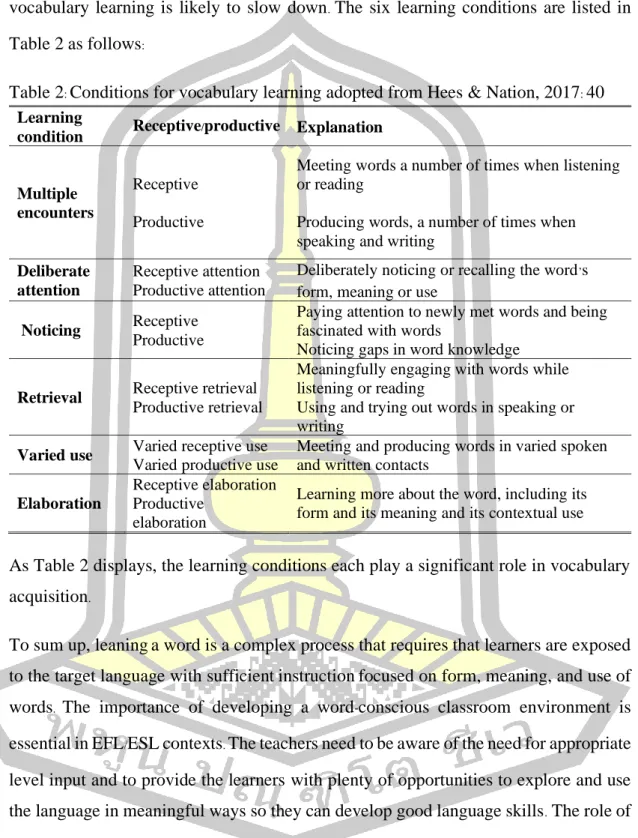
RESEARCH METHODS
A scoring rubric was used to assess participants' productive vocabulary knowledge, as shown in Table 3. The scoring rubric in Table 4 was used to assess participants' receptive vocabulary knowledge. Finally, the delayed posttest was administered two weeks after the end of implementation to test whether participants remembered the target words.
Also, the images were helpful in giving participants a basic understanding of the target words. Participants in the TPR&S group scored higher on the pre-test and post-test. Furthermore, retention of the target words decreased somewhat from post-test to delayed post-test, except for participants in the TPR group, who increased their retention.
Furthermore, participants in the singing group significantly increased their productive vocabulary knowledge of the target words from pre-test to post-test with a large effect size (p=0.01, d=1.735). Furthermore, participants in the TPR&S group improved their productive knowledge of the target words from pre-test to post-test with a large effect size (p=0.01, d=2.447). In short, participants in all three intervention groups significantly improved their productive vocabulary knowledge of the target words from pretest to posttest.
The insignificant difference between the intervention groups on each test may indicate that the teaching methods were equally effective in improving the participants' productive vocabulary knowledge of the target words. The line graph also reflects that the participants' overall progress from the pre-test to the post-test was significant for receptive and productive vocabulary knowledge. Their improvement from the posttest to the delayed posttest may indicate that the participants' receptive vocabulary knowledge of the words was more profound compared to their productive vocabulary knowledge.
Moreover, there was a significant difference between the participants' receptive vocabulary knowledge and their productive vocabulary knowledge. Finally, the results indicate that the participants' receptive retention of the target words was better than the productive retention (Tables 8 & 10). The results indicate that the participants' receptive and productive vocabulary acquisition of the 12 target words improved significantly within groups.
Therefore, implicit learning of the target words may be necessary to focus participants' deliberate attention on the target words. The analysis of the findings shows a statistically significant difference between the participants' receptive and productive vocabulary knowledge. Furthermore, as participants acquired the target words receptively, productive vocabulary acquisition was more likely to occur.
The analysis of the qualitative data revealed that the participants' responses to the interventions helped their vocabulary acquisition.
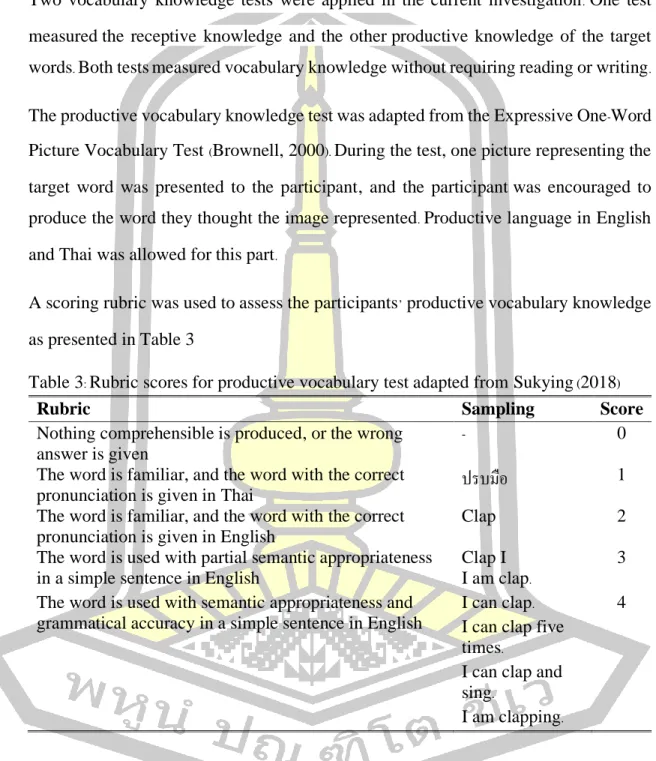
RESULTS
DISCUSSION AND CONCLUSION
